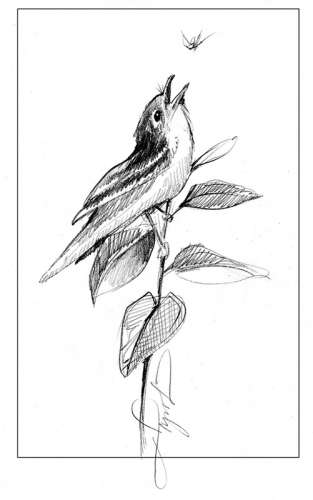
By mid-May each year I begin to look forward to the return of the alder flycatchers that nest in the willows along the stream near our house. Usually the last migrant to arrive on our property, this small, drab, gray bird with its sneeze-like song, signifies that summer is indeed just around the corner. But last year, for the first time in 20 years, another bird joined the neighborhood. A willow flycatcher announced his presence, just a few days after I first heard the alder flycatcher. To my surprise, the two sibling species co-existed all summer, presumably both nesting in the same acre or so of shrubby wetland habitat.
As any birder can tell you, members of the Empidonax genus of flycatcher are notoriously difficult to identify by sight. In fact, for more than 100 years, the alder (Empidonax alnorum) and willow (E. traillii) flycatchers masqueraded as a single species, known as the “ Traill’s flycatcher.” John James Audubon came up with that name, in honor of Thomas Stewart Traill, a Scottish physician and naturalist who helped Audubon find a publisher for his book, The Birds of North America. This error persisted until 1973 when the American Ornithologists Union split the Traill’s into sibling species that are virtually identical in appearance. Even bird banders can’t reliably identify which of the two species they may be holding in their hand, unless the bird is cooperative enough to break out in song. The alder flycatcher sings a harsh, fuzzy, ree-BE-o, or perhaps just a rising, ree-BE, with the accent on the middle or last syllables, respectively, while the willow sings a wheezy, RITZ-bew, with the emphasis on the first syllable.
Most passerines (better known as songbirds), learn their songs as nestlings, typically from their father who sings nearby. However, if they are exposed to the wrong tutor, they can learn abnormal songs or complete songs of a closely-related species. The songs of flycatchers and their relatives, however, are encoded directly into their genetic material, so that upon hatching each bird knows exactly what song to sing without any exposure or tutoring from adults.
In one elegant experiment, Donald Kroodsma, professor emeritus at the University of Massachusetts and a leading authority on avian vocal behavior, raised young alder and willow flycatchers in the lab, exposing each to the song of the opposite species. Despite this confusing situation, both birds developed normally and sang their own species' song. As Kroodsma pointed out, “knowing that songs are innate is important, so that, when surveying flycatchers and their relatives in the frontiers of the tropics, field biologists can reliably use songs to identify genetically different populations. As a result, many species have been found to consist of several in disguise, much as the alder and willow flycatchers were once considered to be one species.”
In addition to being virtually identical in appearance, both species also occupy similar wetland habitats that feature willow, alder, dogwood, and other shrubs. While their distributions are largely separate (alder flycatchers breed across Alaska and Canada to the Northeastern U.S., while willow flycatchers nest mostly south of the Canadian border), their ranges overlap across much of the Northeast.
The willow flycatcher, being at the northern limit of its range in our area, is less widespread than the alder and more confined to low elevation bottomlands, such as the Champlain and Connecticut River valleys, and New Hampshire’s lakes region and coastal plain. In contrast, alder flycatchers are relatively widespread across northern New England, occupying almost any shrubby wetland habitat. However, in conifer-dominated, boreal wetlands and in higher elevation montane-fir forests, the alder is replaced by the aptly-named yellow-bellied flycatcher.
As their name implies, flycatchers feed primarily on flying insects, which they capture on the wing or glean from leaves and branches while hovering. Their primary hunting style consists of watching for prey from a perch, and then flying out to nab an airborne insect, and immediately returning to a perch. In part because of this dependence on an insect diet, as well as over-wintering in the neotropics, both species arrive relatively late in the spring and depart early in fall. Presumably, their late spring arrival coincides with the emergence of flying insects, including wasps, bees, winged ants, beetles, flies, caterpillars, moths, and others.
So the next time you find yourself near a shrubby wetland of speckled alder or pussy willow, listen for these sibling flycatcher species. I know I’ll be eager to hear if the willow’s RITZ-bew will again accompany the ree-BE-o of our resident alder flycatcher.


Discussion *